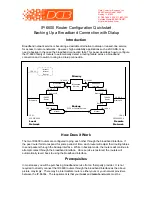
Data Comm for Business, Inc.
2949 County Road 1000 E
Dewey, IL 61840
217-897-6600, FAX 217-897-1331
Outside Illinois: 800-4DCBNET
http://www.dcbnet.com
5. Ethernet-B Static Routes
– Set a host route to the remote IP-6600’s Ethernet-B interface.
For our example, this would be an entry of Target: 10.225.0.8, Netmask: 255.255.255.255,
Gateway: 10.225.0.8, Failover: No. This routing entry is unnecessary because the routers
are directly connected. However, it has been included to illustrate setting a host route, which
would be necessary if the routers were not directly connected.
6. Serial-A Operating Mode
– Leave all of these settings in their default state including the
disabled Port Mode.
7. Serial-A PPP Options
–From the default configuration set the local IP address to
192.168.0.1 and the remote IP address to 192.168.0.2
8. Serial-A Static Routes
– Set a default route to the remote router. This would be an entry of
Target: 0.0.0.0, Netmask: 0.0.0.0, Failover: Yes. Notice that this is a failover route. Its
counterpart was set back on step 4.
The local IP6600 is configured. Don’t forget to activate and save your changes.
Remote IP-6600
1. Ethernet-A IP Configuration
– Set the IP address and Subnet Mask for your remote
network. In our example, this would be IP:10.0.2.2, Subnet Mask: 255.255.255.0.
2. Tools/ISP-Failover
- Enable failover and select the ping method. Set Ethernet-B as the
primary interface and Serial-A as the failover interface. Set both the Failover-Time and
Recovery-Time to 10 seconds. Set the Ping Target. This will be the IP address of the local
IP-6600’s Ethernet-B interface. For our example, this would be 10.225.0.7. Enable the Block
Default Route field.
3. Ethernet-B IP Configuration
– Set the IP address and Subnet Mask for your primary
connection. In our example, this would be IP: 10.225.0.8, Subnet Mask: 255.255.255.0.
4. Ethernet-B Static Routes
– Set a default route to the local router. For our example, this
would be an entry of Target: 0.0.0.0, Netmask: 0.0.0.0, Gateway: 10.225.0.7, Failover: Yes.
Notice that this is a failover route.
5. Ethernet-B Static Routes
– Set a host route to the remote IP-6600’s Ethernet-B interface.
For our example, this would be an entry of Target: 10.225.0.7, Netmask: 255.255.255.255,
Gateway: 10.225.0.7, Failover: No. This routing entry is unnecessary because the routers
are directly connected. However, it has been included to illustrate setting a host route, which
would be necessary if the routers were not directly connected.
6. Serial-A Operating Mode
– Leave all of these settings in their default state including the
disabled Port Mode.
7. Serial-A PPP Options
– Leave all of these settings in their default state.
8. Serial-A Static Routes
– Set a default route to the remote router. This would be an entry of
Target: 0.0.0.0, Netmask: 0.0.0.0, Failover: Yes. Notice that this is a failover route. Its
counterpart was set back on step 4.
The remote IP6600 is configured. Don’t forget to activate and save your changes.

























